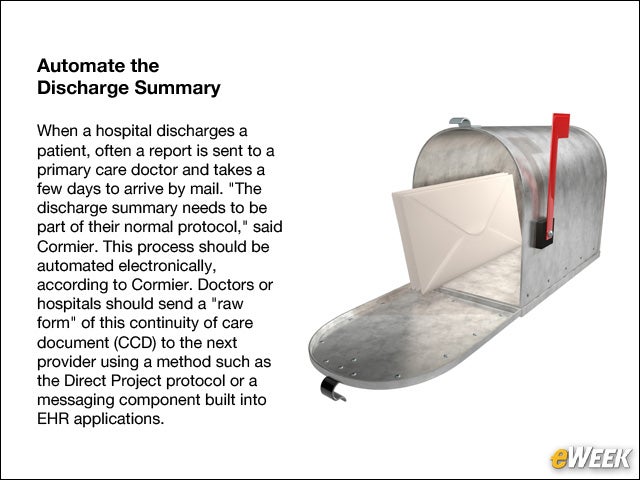eWEEK content and product recommendations are editorially independent. We may make money when you click on links to our partners. Learn More.
1Start With Secure Email
“Use any means you’ve got to send the information electronically,” Cormier advised. A clinical summary containing the patient’s diagnoses, current medications and allergy info can be sent using basic tools, such as secure email. “Being able to send that information is one of the bigger challenges for coordinated care, and often the information can’t get there in time,” she said. “Leverage any tools you can in order to be able to create a clinical summary in a format the next provider can take advantage of,” said Cormier. Messaging electronically in near-real time should be faster than paper, Cormier noted.
2Message Through the Direct Project Protocol
To send patient information, doctors can use the federal Direct Project protocol to send data in a secure email as an attachment. “The Direct Protocol bridges the technology gap between networks or between providers,” said Cormier. Doctors can receive emails containing patient information about their clinical summaries and medications. “Having the right information at the right time really becomes important for coordinated care,” she said.
3Automate the Discharge Summary
When a hospital discharges a patient, often a report is sent to a primary care doctor and takes a few days to arrive by mail. “The discharge summary needs to be part of their normal protocol,” said Cormier. This process should be automated electronically, according to Cormier. Doctors or hospitals should send a “raw form” of this continuity of care document (CCD) to the next provider using a method such as the Direct Project protocol or a messaging component built into EHR applications.
4Access Web Portals
Statewide health information exchanges (HIE) offer Web portals that allow doctors to send CCD instructions in secure, encrypted formats. Some state HIEs enable doctors to log in and see alerts from other providers, Cormier noted. The Web portals allow doctors to inquire about a patient’s status in a Google-like search field. EHR companies, such as eClinicalWorks, offer interoperable portals that allow doctors, specialists, nursing homes, labs and pharmacies to share data in a vendor-neutral system. Meanwhile, a data-extraction tool from Caradigm called the Minimum Data Set (MDS)-to-CCD transformer allows nursing facilities to share data with a primary care physician.
5Send Out Inquiries to Caregivers
6Use the Record Locator Service
More advanced than the Direct Project email protocol, a Record-Locator Service (RLS) is a component of an HIE that provides information on where a patient is located in an extended health network. “While a longitudinal health record is the ideal solution, [an RLS] can serve as the tool to search and find information on a particular patient within a network of care providers,” said Cormier. It doesn’t provide the actual records or lab tests but helps doctors send a broadcast search request to see where patient records are stored. Algorithms in the RLS allow doctors and clinicians to match patients according to their search criteria. The requesting and responding provider must have patient consent, Cormier noted.
7Adopt Population-Management Tools
In an accountable care organization (ACO), a team of doctors, hospitals and clinics responsible for a set of patients, can use population care-management tools, such as those by Phytel, to bridge care gaps and analyze data for patients with chronic conditions, such as diabetes. These applications can provide a list of patients in a practice that all suffer from diabetes, said Cormier. Doctors can then compile reports based on these rules-based queries to see how many visits a patient might need in a three-month period, said Cormier. “ACO with multiple care providers go to one place to find out everything about your at-risk patients who are diabetics—and that you’re providing the right care and that you’re in budget,” said Cormier.
8Private HIEs in ACOs Are an Option
A step beyond secure email, private HIEs are used by ACOs, which are groups of doctors that are accountable for patients’ health outcomes. “Most often, these private HIEs come together [in] ACOs to take advantage of the Medicare [incentives],” said Cormier. If doctors aren’t yet set up for the potential interoperability of a statewide HIE, a private HIE allows caregivers to communicate with one another if they’re in the same network. A hybrid private-public HIE might be best, Jason Goldwater, vice president of programs and research at the eHealth Initiative, told eWEEK in November. “You want to have compatibility and exchange between disparate systems,” he said.
9Attach Continuity of Care Documents to EHRs
10Take Advantage of Cloud Applications
Rather than building an EHR or HIE repository internally for doctors to pool their resources with other providers, a hosted model in the cloud allows them to back up patient data at an external site and save money on the costs of managing the data. “Focus on the exchange of information rather than having to manage a giant data repository,” Cormier advised. Growing the amount of big data in patient records is easier in the cloud than in-house, she said.









